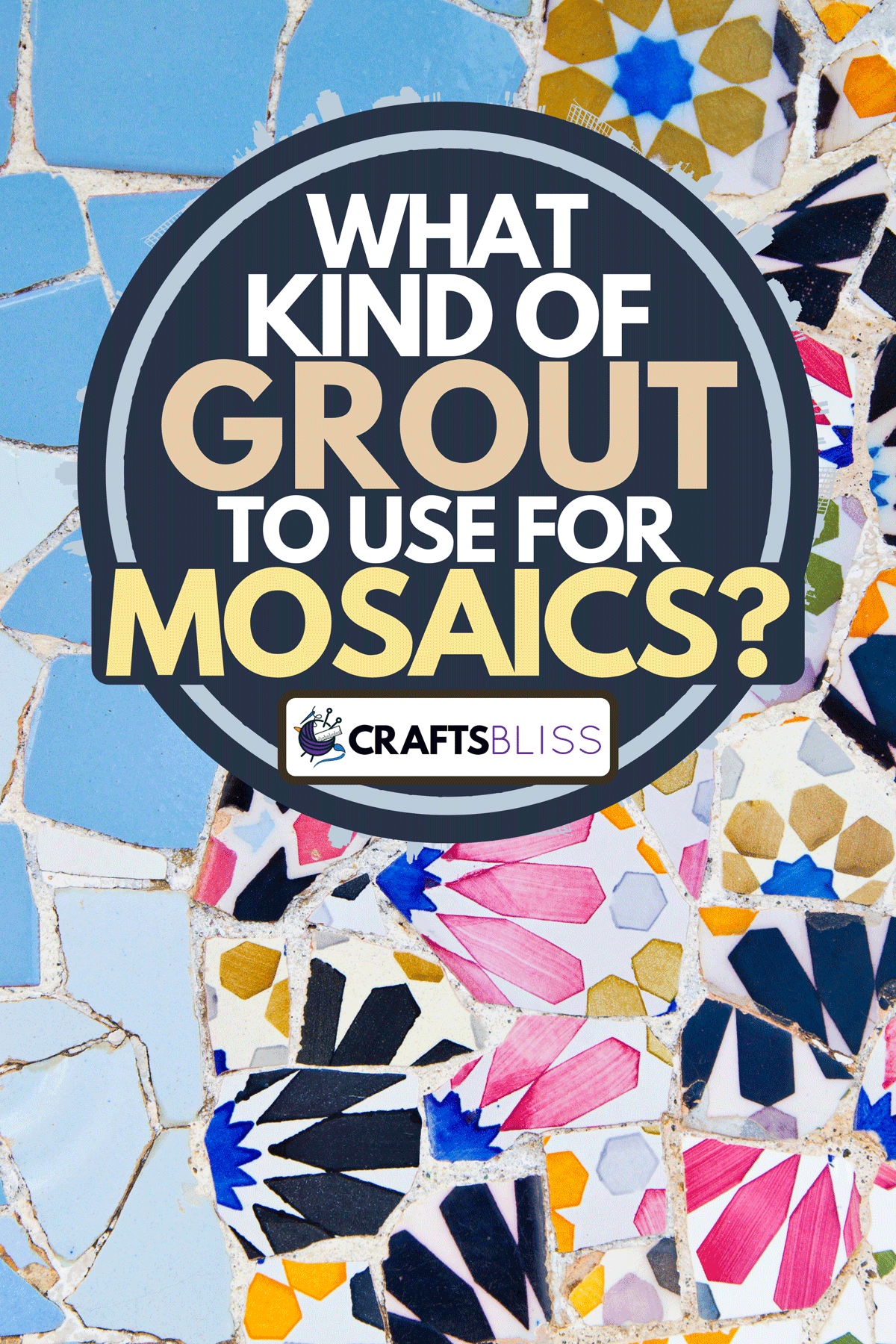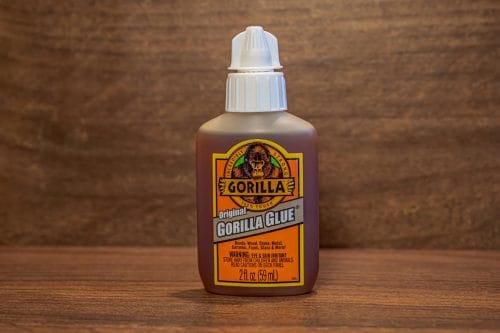As you are getting ready to create your home masterpiece, you may be considering what kind of grout would be best to pull it all together. We have been researching and have found the best grout for mosaic arts in the décor.
The best kind of grout for use with mosaics is sanded epoxy grout. Epoxy grout is made of filler powder combined with epoxy resins; it is waterproof and stain-resistant. Sanded grout stands up to high usage and does not crack the way un-sanded grout can. Epoxy grout is not porous, so there is no need to seal it. Once you have finished your artwork, you'll have an easy to clean, low maintenance surface.
We have found even more interesting details for you about different kinds of grouts and adhesives. We will cover the application of grout on the mosaic and some troubleshooting options. Stay tuned while we explore the world of grouts!

Types of Grout
Sanded grout has added strength, which helps it resist the cracks that happen due to shrinkage. Use sanded grout for spaces of 1/8 inches wide or larger between pieces as it's hard to fit in tighter spaces. A non-sanded grout is used in areas that are smaller than 1/8 inches wide. The smooth texture goes into these areas easier.
Epoxy Grout
Epoxy grout is an epoxy resin combined with a filler powder, making it waterproof and stain-resistant. The durability makes it an optimal choice for backsplashes and fountains. It does not need to be sealed.
Epoxy grout needs to be applied in stages as it takes longer to apply and sets faster than other types of grouts. It is less forgiving and can highlight any imperfections.
Click here to see this epoxy grout on Amazon.
Powder Grout
Powder grout is a cement-based mix that is not waterproof. It will need to be sealed the first time then resealed regularly to maintain waterproofing.
Click here to see this grout on Amazon.
Premixed Grout
Premixed is ready-to-use grout.
Do you have to grout a mosaic?
Whether to grout your mosaic is really the artist's preference. However, if your piece will be displayed outdoors or in a damp environment like a shower or fountain, it is best to grout. The grout will protect your tiles from moisture leaching through, to help keep them in place. For indoor mosaics, it is less imperative to apply grout and will depend on how you want your finished look.
How Do You Grout A Mosaic?
There are a few steps that need to happen before applying the grout. Firstly, use caution and wear personal protection equipment (PPE) when working with mosaic and grout. The materials can be sharp, dusty, and often heavy. Adhesives can produce irritating fumes, so best to wear eye protection, gloves, and a mask. We'd suggest preparing by getting:
- safety goggles,
- dust mask,
- rubber gloves,
- strong base for your work table to support the weight of the mosaic and materials.
Apply Grout Sealer First
If working with porous surfaces, such as stone tiles or unglazed ceramic tiles, use a sealer to preserve the surfaces. This will help the pieces maintain their color and prevent the grout from staining them. To darken your stone tiles, use a stone enhancer instead of a tile and sealer.
Allow Glue to Dry Completely After Arranging Mosaic
Glue the tiles to the surface to create your mosaic. Wipe away any excess glue, then allow 24 hours for the glue to cure before applying grout. We've got some great suggestions for tile adhesives, just have a look below.
PVA Glues
PVA adhesives are water-based PVA (polyvinyl acetate) glue. It dries clear, it is water-resistant, has no fumes, is non-toxic, and cleans up easily. Use only for indoor projects as any humidity can loosen the bond. PVA glue bonds well with fiberglass mesh, any style of tile, and wooden or acrylic surfaces.
Click here to see this tile adhesive on Amazon.
Thin-set Mortar
Thinset Mortar is a sticky concrete with polymers. It is suited well for outdoor mosaic art. Make sure to follow the instructions on the package for mixing, handling, and disposal. Use thin-set on porous surfaces like cement, wood, and terracotta. If you use it on non-porous surfaces, make sure to mix the thin-set with admixes instead of water. Admixes are latex or acrylic liquids that make the thin-set sticky.
Click here to see this gray thin-set mortar on Amazon.
Silicone
Use silicone on glass surfaces such as small projects like sun catchers because it comes in transparent varieties. Silicone comes in a caulking tube and can take some to get comfortable using. Be cautious about over-applying as it is hard to remove. It will also squeeze up through the tiles and make grouting difficult. When using larger sheets, the middle has a hard time curing completely.
Click here to see this silicone on Amazon.
Epoxy Adhesive
Use epoxy on metal surfaces. It does decently on wood and glass and holds up outdoors. Beware that epoxy adhesive is odiferous, and have plenty of ventilation when working with it. Once it is mixed, it has to be used quickly. Excess cannot be saved for later. It is a powerful adhesive and dries clear.
Click here to see this epoxy adhesive on Amazon.
Set Up Your Workspace
Set up the work area. Outdoors is best to avoid dust contamination, allow ample ventilation and ease of clean up. You'll need to gather:
- bucket of water,
- tray to mix the grout,
- stirring stick or margin trowel (to mix the grout),
- timer,
- sponge,
- rubber gloves,
- dust mask,
- rags or paper towels.
After arranging the mosaics into the desired design and selecting a mosaic adhesive (grout is not sticky enough to set the tiles), adhere the pieces to the rigid surface. Wait until the mosaic adhesive is completely dry before starting the grouting process. Drying takes about 24 hours.
Clean with a damp sponge.
Mix The Grout
Epoxy Grout
Epoxy grout comes separated, with part A in a smaller bucket and part B in a larger bucket. Part A contains the hardener and sometimes the colorant. Follow the manufacturer's instructions to carefully mix the two parts.
Here's a quick video on how to mix and use epoxy grout.
Powder Grout
Make sure to don a dust mask when working with powder grout. Mix the amount of grout needed according to the manufacturer's instructions. More can always be incorporated.
Click here to see this powder grout on Amazon.
Apply The Grout
Use a plastic drop cloth underneath the project to catch excess grout as you apply it. This way, you can collect the drips and use them as you work, thus wasting less grout.
Click here to see this plastic drop cloth on Amazon.
Grout the mosaic by grabbing a glob of grout with a grout float and spread it across the mosaic until the entire piece is covered in grout. Verify that all of the cracks are filled and that there are no bubbles between the grout and the wood. For non-epoxy grouts, run glove-covered fingers along each crack and push the grout down so that it fills the crevice.
Click here to see a grout float on Amazon.
Use a sponge to wipe off any excess grout with flat passes across the surface. (Rags will catch sharp edges.) Do not scrub. Make sure not to wash the grout out between the tiles. Rinse and wring out the sponge after each pass.
After removing the bulk of the excess grout, there will be a thin grout haze left. Let it dry for a few moments so that it's easier to see, and use a dry cloth to wipe it off. Look for areas where the grout has built-up on any tiles. Wipe clean making sure the grout is flush or slightly lower than the tiles around it.
Epoxy grout needs to stay dry while it cures. For other grout types, keep the surface damp while the grout cures. (The surface can crack if part of it dries faster than others.) Keep covered with plastic to make sure not to let any drops accumulate on the surface of the mosaic.
Check out this visual demonstration of how to use a grout float to spread the grout across mosaics, below:
Grout Clean-up
Do not dispose of extra grout down your drains as it is are not good for plumbing. Use an old coffee can or milk container to pour the extra in and allow it to harden. After a day or so, pour off any excess water and throw the container away.
What color grout for my mosaic?
Contrasting colors are best to accentuate your tiles. Black grout contrasts with most colors. But, for a clean matte look, use white grout. Be cautious in your selection because white can overshadow the tiles.
Although black or white are the most commonly used grout colors, there are a variety of options. You can use a concrete pigment (ranging from brown, terracotta, red, and slate green, among others) to color grout any shade you prefer to coordinate with your tiles. Always sample your color choice on a small, inconspicuous area first to ensure you are pleased with the result.
Click here to see different color grout colorants on Amazon.
If the grout color doesn't work with the design, don't panic! Use a grout remover tool to remove the grout and reapply with another color.
Click here to see the grout remover tool on Amazon.
Alternatively, you can use acrylic paint to cover the grout's surface. It's easy for smooth glass tiles to take a cloth and wipe the paint with the same motions originally used when applying the grout. For rough or porous tile, use a small paintbrush and paint the lines carefully as there's no way to wipe away any mistakes.
Does The Grout Need To Be Sealed?
Epoxy grout is not porous and thus does not need to be sealed. Other grout types will need to be sealed because, over time, water and grime will penetrate the grout causing tiles to crack and break.
Seal natural stone surfaces before applying grout, whether using epoxy grout or another type. Stone is a porous surface, and the sealant will protect it. If you aren't sure whether to seal the surface before adhering and grouting, test existing tile surfaces by dripping a few drops of water onto the tile. If the water is absorbed, then assume it is a porous surface and should be sealed.
Click here to see this stone sealer on Amazon.
How Long Does It Take For Mosaic Grout To Dry?
Epoxy grout cures in 24 hours. Other grout types typically take between 24 to 72 hours to cure.
How Much Grout Do You Need For Mosaic Tile?
To calculate the amount of grout that will be needed, multiply the mosaic's length by width, add the tiles' thickness, and width of any gaps between tiles' spacing. For example, a mosaic that is 18 inches by 18 inches, with gap widths of less than 1/4 inch, and tiles less than 3/8 inch thick should require two pounds of grout for sufficient coverage.
What Do You Do If Grout Is Too Runny?
Epoxy grout does not use water and comes in pre-measured units that must be mixed all at once. The manufacturer includes everything needed for epoxy grout. For other grout types, add more dry grout to the mixture until it reaches the right consistency.
In Conclusion
The best grout for mosaics is epoxy grout, even though it's a little more challenging to apply. Applied correctly, grout makes the art in the mosaic stand out.
For more about mosaic art, read our articles about "How To Make A Mosaic At Home?" and "How To Make A Mosaic Waterproof?"


















